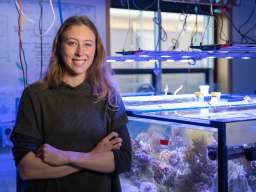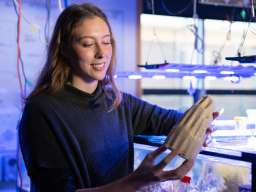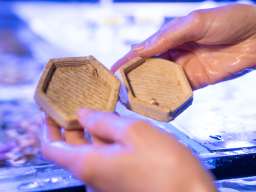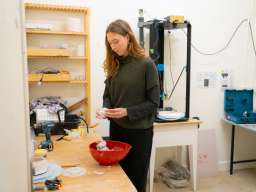Reefinement: Using design and science to support reef ecology

Beth O’Sullivan Beth has researched and developed a new biomaterial that has the potential to be used as a settlement substrate for small-scale localised reef restoration and recovery. Pic: Nic Vevers/ANU
Written by Neha Attre
Climate change is one of the factors posing a serious threat to coral reefs globally and researchers around the world are looking for solutions.
One such researcher is Beth O’Sullivan, an Honours student at The Australian National University (ANU) School of Art and Design (SoAD), who is looking for an environmental-friendly solution to coral reef restoration practices which often use concrete.
Beth has researched and developed a new environmentally friendly, low CO2 emission, biomaterial that has the potential to be used as a settlement substrate for small-scale localised reef restoration and recovery.
“The world recognises the urgency to preserve and protect the reefs which led me to research and develop a calcium carbonate-based biomaterial which has a lower carbon footprint than concrete and other materials currently available to industry,” Beth said.
“I felt the need to develop a biomaterial that is environmentally friendly and would have minimal impacts on the reef. The substrate contains no plastics or resins. This biomaterial has similar properties to clay and can be 3D printed, cast and hand moulded, which means it can take on many forms both simple and complex.”
This material is cost-effective and can be scaled for use in a variety of contexts, including marine ecological research and artificial reefs.
Beth is a Design Honours student working out of the ceramic studio under the expertise and supervision of Roderick Bamford, Head of Ceramics and Art & Design lecturer at the ANU. She also has a degree in science where she majored in ecology and specialised in genetics, and works with coral reef scientist, Dr Jennie Mallela, an honorary supervisor/advisor, who is supporting the work from a scientific and marine ecological perspective.
This month, the marine objects have been placed in The Australian National University’s reef tank at the ANU Research School of Earth Sciences where a pilot study has been set up to investigate biological settlement reef growth on this new biomaterial, to evaluate its success and viability. The reef tanks were set up several years ago with seawater brought from Batemans Bay.
Beth has been working across three different schools within the ANU (School of Art and Design, School of Biology, and Research School of Earth Sciences).
Beth chose to pursue her research through the Design Honours program because it gave her the opportunity to experiment and explore freely taking advantage of design methodologies and processes and applying them to scientific, ecological, and sustainable scenarios.
“Researching as a designer allows you to work in several areas at the same time. It doesn’t constrain you to a specific discipline, it allows you to explore the world around from a unique research space,” Beth said.
“The School of Art and Design is perfectly positioned for transdisciplinary research across the university. I am looking forward to seeing the school support important science and design (Bio-design) research as more students become interested and involved in the area.”
Dr Mallela, Beth’s honorary supervisor/advisor, is a multidisciplinary environmental scientist and coastal expert. Her areas of expertise include coral reef science, climate change processes, ecology, environmental monitoring and geochemistry.
A few years ago, Dr Mallela worked on a project with SoAD’s Ceramics Department in which Art School students designed substrates with the equivalent of very small fish bite marks on them.
“The substrates were placed in the reef and 97 per cent of the baby corals landed in the grooves that looked like small fish bites overgrown by Pink Coralline Algae. It demonstrates the importance of thoughtful design when it comes to reef restoration practices,” Dr Mallela said.
When Beth approached Dr Mallela, she felt it was a brilliant idea. “Her dedication and perseverance to developing a material that is environment-friendly is incredible,” Dr Mallela said.
Roderick Bamford, Senior Lecturer at SoAD, has been guiding Beth with the material design and the potential creative applications of her experimental research.
“The design aspect explores the use of contemporary methodologies such as computational design and digital fabrication which is a key part of Beth’s project,” Mr Bamford said.
“The creative use of design strategies can help researchers collect and analyse information and subsequently provide scalable artificial reef supports that improve the prospects for coral rehabilitation. The novel material can be formed by hand, casting, machine moulding and 3D Printing, a versatility that lends its application to a variety of marine environments.”
Beth is the recipient of the John and Elizabeth Baker Honours Scholarship and she will be using the funds to support and continue her Honours research which includes further tests, development, and analysis.
“My initial tests in a controlled laboratory environment suggest that this material has broad potential and I hope to continue this research in an Industry-linked PhD next year,” Beth said.
Beth’s work will be exhibited at the School of Art and Design Graduate show at the end of this year. This an exhibition where third-year, honours and Masters student work is exhibited and the opportunity to see all the exciting work being made across the school over the year.
Beth is currently looking for an industry supporter to collaborate and help fund an industry-ANU-linked PhD next year. If you’re interested in knowing more about this or her work in general, you can contact Beth beth.osullivan@anu.edu.au






